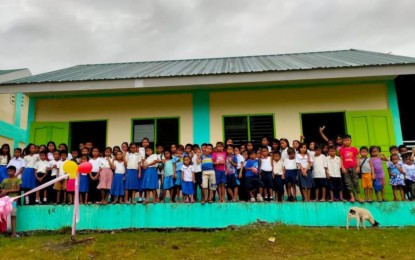
NEW CLASSROOMS. T’boli school children of Barangay Maan, T’boli town in South Cotabato province pose in front of a new two-classroom school building completed last year under the Department of Social Welfare and Development’s (DSWD) Kapit-Bisig Laban sa Kahirapan-Comprehensive and Integrated Delivery of Social Services or Kalahi-CIDSS program. The school building was constructed in partnership with the Department of Education. (Photo courtesy of DSWD-12)
GENERAL SANTOS CITY -- Some PHP105-million worth of school building projects for indigenous peoples were completed in parts of Soccsksargen last year under the Department of Social Welfare and Development’s (DSWD) flagship poverty alleviation program Kalahi-CIDSS.
Cezario Joel Espejo, DSWD-Region 12 director, said Tuesday they finished at least 32 of the approved 50 school building projects for the region in 2019 in partnership with the Department of Education (DepEd).
He said these were implemented in IP communities in the provinces of South Cotabato, Sultan Kudarat, Sarangani and North Cotabato.
“The school buildings are now being used by the recipient communities, benefitting around 5,500 IP school children,” he said in a statement.
These children include those from the Blaan, Tboli, T’duray, Tagakaulo, Manobo Dulangan, Tagabanwa Manobo, Erumanen Ne Menuvu and Uvu Manobo tribes, he said.
Espejo said the school buildings were identified by the recipient IP communities as priority projects under the Kalahi-CIDSS, which stands for Kapit-Bisig Laban sa Kahirapan-Comprehensive and Integrated Delivery of Social Services.
He said the construction of the school buildings was funded by DepEd.
Espejo said that unlike the usual government-funded school buildings, the recipients were given the liberty to choose the name, type and other aspects of classroom construction.
“This is a unique project because it values the tribes’ cultures, traditions and practices,” he said.
He said the new school buildings were expected to bring “better quality education and improve service delivery to school children in geographically isolated and disadvantaged areas in the region.”
He said they are hoping that these will usher in better opportunities for the area’s IP communities, which remain among the most marginalized and disadvantaged sectors.
Kalahi-CIDSS, which was first implemented by DSWD through support from the World Bank in 2002, is one of the government’s poverty-alleviation programs that “uses the community-driven development approach to empower communities in targeted poor and disaster-affected municipalities.”
Through the program, the government allotted around PHP500 million last year for the construction of 315 school buildings for IP areas in Mindanao. (PNA)
